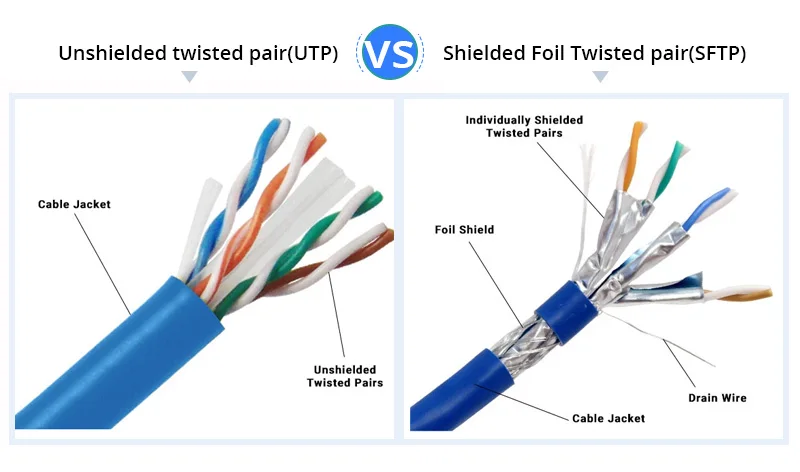The most commonly used twisted pair copper Ethernet cables include Cat5e, Cat6, Cat6A, and Cat7. Although fiber optic cables are increasingly used today, twisted pair copper Ethernet cabling still can't be replaced in many application areas. In practice, most network faults are caused by poor or unsuitable cabling systems. Therefore, choosing a suitable Ethernet cable is vital for your business or home networks. Then you must know what are the differences between Cat 5e vs Cat 6 vs Cat 6A vs Cat 7 and be clear that when to choose the right one for specific applications. I hope this article will help.
Cat5e Ethernet cable developed from Cat5 cable by mitigating crosstalk and has mostly displaced Cat5 in today's application. It features an unshielded twisted pair structure and provides a bandwidth performance of up to 100 MHz.
Ethernet Cat5e cable is commonly applied in 1000BASE-T Gigabit Ethernet speeds by using four wire pairs. Cat5e cable supports distances up to 100 meters in 1 Gigabit Ethernet connection by working with 1000BASE-T SFP+ transceivers.
1000BASE-T link on Cat5e:

Cat6 is also an unshielded twisted pair cable, which has a better bandwidth performance of up to 250 MHz, compared to 100 MHz for Cat 5e. Also, it complies with a more strict specification standard in crosstalk and system noise than Cat5e cable.
Cat6A (Augmented Cat6) was defined by TIA (Telecommunications Industry Association). The bandwidth of Cat6A is up to 500 MHz, which is twice that of Cat 6. Furthermore, Cat 6A has improved alien crosstalk as compared to Cat 6.
Cat6 supports the max distance up to 100 meters in 10/100/1000BASE-T applications. When used for the 10 Gigabit Ethernet 10GBASE-T application, Cat6 has a limited distance of 55 meters while Cat6a allows for 100 meters. QSFPTEK provides 10GBASE-T modules with specifications of 30 meters and 100 meters.
10GBASE-T link on Cat6A:
Cat 7 Ethernet cable features an individual shielding per pair structure different from unshielded Cat5/5e/6. The advantages of Cat7 aim at the better performance of EMI and crosstalk protection, especially in high-speed rate transmission systems.
Cat 7 Ethernet cable has a high bandwidth of up to 600 MHz. It terminates GG45 or TERA connectors, whereas Cat5/5e/6 uses the traditional Rj45 connectors.
It should be noticed that Cat7 is not recognized by the TIA/EIA. So the compatibility issue must be paid enough attention to when you select Cat7 for your network infrastructure.

Cat5e vs Cat6 vs Cat6a vs Cat7
The wider the bandwidth, the higher the transmission speed. Both Cat5e, Cat6, and Cat6A Ethernet cable support 1 Gigabit 1000BASE-T network transmission speeds up to 100 meters distance, however, as the bandwidth of Cat6 and Cat6A is much higher than Cat5e Ethernet cable, coming to the result that Cat6 and Cat6a wiring allows a faster speed up to 10GBASE network transmission. When operating at up to 10Gbps, Cat6 allows for maximum lengths of 55 meters, while Cat6A supports up to 100 meters. Therefore, Cat6 and Cat6A definitely significantly outperformed Cat5e.
Cat5e - Up to 1Gbps speed,100 MHz bandwidth, 100 meters distance.
Cat6 - Up to 10Gbps speed, 250 MHz bandwidth, 55 meters distance.
Cat6A - Up to 10Gbps speed, 500 MHz bandwidth, 100 meters distance.
Cat7 - Up to 10Gbps speed, 600 MHz bandwidth, 100 meters distance.
Cat5e and Cat6 Ethernet cables are characteristic of an unshielded twisted pair structure (UTP), whereas Cat6A and Cat7 adopt a shield foil twisted pair structure (SFTP). The major difference between these two types of structures is if using shield protection, which results in the performance differences in EMI and crosstalk. Cat6A and Cat7 enjoy better protection from EMI and crosstalk compared to Cat5e and Cat6. However, it leads to a relatively higher cost and a thicker wire diameter. So although Cat5e and Cat6 are not as good as Cat7 in the performance of againsting EMI and crosswalk, they get the advantages in low cost and easy deployment.

Unshielded Twisted Pair (UTP) vs Shield Foil Twisted Pair (SFTP)
Cat5e vs Cat6 vs Cat6A vs Cat7 Specification
No previous
NEXT:Fiber Optic Cable Types: Single Mode vs Multimode Fiber Cable
RELATED NEWS
CATEGORIESLATEST NEWSCONTACT USContact: Mr.Tony Phone: +86-13418458707 E-mail: support@glovion.com/ tony@glovion.com Add: No. 42 North Pinchuangyuan Industrial Park Industrial East Road, Longhua Street, Longhua District, Shenzhen |